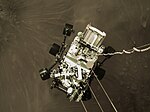2021 UA1
Appearance
 Orbit of 2021 UA1 | |
| Discovery[1] | |
|---|---|
| Discovered by | Catalina Sky Survey |
| Discovery date | 25 October 2021 |
| Designations | |
| 2021 UA1 | |
| |
| Orbital characteristics[3] | |
| Epoch 2021-Jul-01 (JD 2459396.5) | |
| Uncertainty parameter 6 | |
| Observation arc | 0.9 days[2] |
| Aphelion | 1.35 AU (Q) |
| Perihelion | 0.6139 AU (q) |
| 0.98 AU (a) | |
| Eccentricity | 0.3750 (e) |
| 0.97 years | |
| 312.8° (M) | |
| Inclination | 10.19° (i) |
| 211.6° (Ω) | |
| 66.27° (ω) | |
| Earth MOID | 0.000064 AU (9,600 km) |
| Jupiter MOID | 3.7 AU (550,000,000 km) |
| Physical characteristics | |
| Dimensions |
|
| 31.8[3][4] | |
2021 UA1 is a small (~2 meter) near-Earth object that passed about 3047 km from the surface of Earth while passing over Antarctica on 25 October 2021 around 03:07 UT.[5][a] Given the small size of the asteroid it only reached the brightness of Pluto at around apparent magnitude 14.[5] Since it approached from the direction of the Sun, it was not discovered until 4 hours after closest approach.[1]
| Asteroid | Date | Distance from surface of Earth |
Uncertainty in approach distance |
Observation arc | Reference |
|---|---|---|---|---|---|
| 2020 VT4 | 2020-11-13 17:21 | 368 km | ±11 km | 5 days (34 obs) | data |
| 2020 QG | 2020-08-16 04:09 | 2939 km | ±11 km | 2 days (35 obs) | data |
| 2021 UA1 | 2021-10-25 03:07 | 3049 km | ±10 km | 1 day (22 obs) | data |
| 2023 BU | 2023-01-27 00:29 | 3589 km | ±<1 km | 10 days (231 obs) | data |
| 2011 CQ1 | 2011-02-04 19:39 | 5474 km | ±5 km | 1 day (35 obs) | data |
| 2019 UN13 | 2019-10-31 14:45 | 6235 km | ±189 km | 1 day (16 obs) | data |
| 2008 TS26 | 2008-10-09 03:30 | 6260 km | ±970 km | 1 day (19 obs) | data |
| 2004 FU162 | 2004-03-31 15:35 | 6535 km | ±13000 km | 1 day (4 obs) | data |
The 2021 Earth approach lifted the orbit and increased the orbital period from 356 days to 413 days.[6] This changed it from an Aten asteroid to an Apollo asteroid.
| Parameter | Epoch | Period (p) |
Aphelion (Q) |
Perihelion (q) |
Semi-major axis (a) |
Eccentricity (e) |
Inclination (i) |
|---|---|---|---|---|---|---|---|
| Units | (days) | AU | (°) | ||||
| Pre-flyby | 2021-Jul-01[3] | 355.6 | 1.351 | 0.614 | 0.982 | 0.3750 | 10.19° |
| Post-flyby | 2022-Jan-01[6] | 413.1 | 1.525 | 0.646 | 1.086 | 0.4046 | 0.006° |

2021 UA1 · Mercury · Venus · Earth · Mars · Sun
Notes
[edit]- ^ Geocentric approach distance 0.000063 AU – 6378 km (Earth radius) is 3047 km. It passed within 4 degrees of the South celestial pole near closest approach.
References
[edit]- ^ a b "MPEC 2021-U95 : 2021 UA1". IAU Minor Planet Center. 26 October 2021. Retrieved 26 October 2021. (K21U01A)
- ^ a b c "Earth Impact Risk Summary: 2021 UA1". NASA/JPL Near-Earth Object Program Office. Retrieved 26 October 2021.
- ^ a b c "JPL Small-Body Database Browser: (2021 UA1)" (Under Close Approach Data select km for distance units). Jet Propulsion Laboratory. Retrieved 26 October 2021.
- ^ "2021 UA1 Orbit". Minor Planet Center. Retrieved 26 October 2021.
- ^ a b "Horizons Batch for 2021-10-25 03:06 UT". JPL Horizons. Archived from the original on 26 October 2021. Retrieved 26 October 2021.
- ^ a b "Horizons Batch showing epoch 2021-Jul-01 and 2022-Jan-01". JPL Horizons. Retrieved 26 October 2021.
External links
[edit]- 2021 UA1 Close approach date: 2021 10 25.130000 (03 07 12.0) – MPC diagram using WebGL
- 2021 UA1 – Tony Dunn (Gravity Simulator)
- 2021 UA1 – David Rankin (Catalina Sky Survey)
- 2021 UA1 at NeoDyS-2, Near Earth Objects—Dynamic Site
- 2021 UA1 at ESA–space situational awareness
- 2021 UA1 at the JPL Small-Body Database



